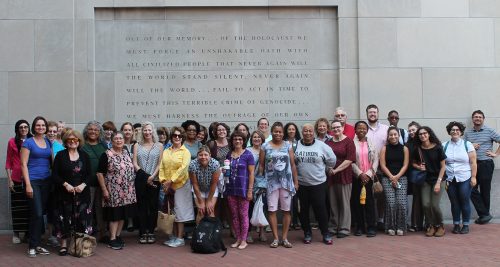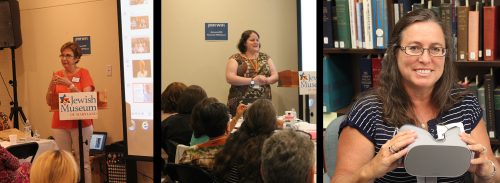Highlights from the 2019 Summer Teachers Institute

For this month’s edition of JMM Insights, Director of Learning and Visitor Experience Ilene Dackman-Alon shares highlights of this year’s Summer Teachers Institute. This annual educator training has become a core part of the JMM calendar. It has never been more important to enable teachers to effectively share Holocaust history in their classrooms and our program has never been stronger!
~Marvin
Missed any previous editions of JMM Insights? You can catch up here!

Last week, August 5-7, the 2019 Summer Teachers Institute (STI) brought together a community of learners to explore best practices in teaching Holocaust education. The community of learners included over 45 teachers from public, Jewish and private along with a few JMM Board members, staff, volunteers and interns for the 3-day professional development opportunity. This year’s SOLD-OUT program, Women and the Holocaust, provided participants with new ideas as well as new program and education resources to help make Holocaust Education more meaningful for students. The following are program highlights!

Our first day convened at the Jewish Museum of Maryland with a brief tour of the exhibits, Stitching History From the Holocaust and Fashion Statement. Following the gallery tour, Linda Medvin, Director of Florida Atlantic University’s Center for Holocaust and Human Rights Education presented on the theme of Women and the Holocaust. The group examined the many different roles that women play during their everyday lives – their “Universe of Obligation,” and how this sense of obligation pushed women to make sacrifices and accept challenges during the war. One of the highlights of the session was watching the short film Pigeon provided by Facing History and Ourselves, followed by a discussion of obligation. Linda provided resources and materials to help illustrate ways in which women were perpetrators, resistors, rescuers and victims during the Holocaust.
After lunch, JMM Board member, Nancy Kutler shared her mother’s (Hannah Rath) personal story of survival growing up in Germany. Nancy shared with the group that her mother was sent to a ghetto in Riga, Latvia, then to various camps — and ultimately to Stutthof. Following the war, Hannah met her future husband, George Rath, a survivor of the Buchenwald Concentration camp, and the two headed for a new life in the United States and married in 1947. Nancy shared with the group that her mother spent a lot of time in schools sharing her personal story of survival. Nancy found letters from school children after her mother’s death, and this was the catalyst that inspired Nancy to continue to share her mother’s incredible story.

JMM educator, Marisa Shultz, presented a lesson on using historic newspapers in the classroom in connection to the USHMM’s exhibit, Americans & The Holocaust. We debuted the Anne Frank oculus tours of the secret annex in Amsterdam provided by the Anne Frank Center USA; and our teachers had the opportunity to go on tours of the historic synagogues and meet with Jessica Fink, librarian at the CJE Lending library.

Day Two found us in Washington, DC at the US Holocaust Memorial Museum. In addition to viewing the permanent exhibits, we were able to tour a new exhibit, Americans and the Holocaust before the regular opening hours of the Museum. The exhibit examines the motives, pressures and fears that shaped American attitudes and responses to the threats of Nazism and Hitler’s regime during the 1930’s and 1940’s, revealing how much information was available to Americans at the time. We were fortunate to travel to DC with Howard and Esther Kaidenow, both survivors of the Holocaust who shared with the group their experiences of survival during the war. Esther came to the United States and was placed in a Displaced Persons Camp is Oswego, New York which is highlighted in the Americans and the Holocaust exhibit.
After lunch, we travelled to Beth Shalon Synagogue in Columbia where we had the privilege to meet Edith Cord, who shared her experiences growing up in Vienna, Italy and France in her attempt to go into hiding and escape the terror of the Nazi regime. Mrs. Cord’s story is one of strength, and determination as she told her story of survival and the lessons, she learned the hard way. Mrs. Cord spoke about how she rose above the difficult circumstances that transcend hatred, how she was able to find meaning in life and how it is important to protect our freedoms. She shares her experiences and the lessons learned the hard way: how to rise above difficult experiences.

Day Three took place at the American Visionary Museum in connection to the exhibit, Esther and the Dream of One Loving Human Family on display through 2024. The exhibit highlights the beautiful tapestries that Esther Krinitz created illustrating her childhood years growing up in Poland during World War II. Esther’s daughter, Bernice Steinhardt opened the morning highlighting the work of Art and Remembrance, a non-profit organization that uses art and personal narrative to recognize individual courage and resilience, and to foster understanding and compassion for those who experience injustice. Bernice shared the 30-minute documentary, Through the Eye of the Needle that examines the life of Esther Krinitz and how she survived the Holocaust as a teenager and how she came to tell her life story in a series of 36 fabric collages and embroidered panels.
Following the film participants split between the opportunity to go on a tour with Bernice and view the collages or go to a session that highlighted the resources and lesson plans that were prepared by Claire Tesh and lmnoeducation, LLC. In connection to the exhibit. All participants loved viewing the collages and felt that lesson plans were wonderful resources for the classroom.

We make sure to collect evaluations from participants after each day of the Summer Teachers Institute. We were delighted by the responses and feedback we received, here are just a few:
>“Since this is my first time here @ STI, I’ve loved everything. Thank You!!!”
>“I enjoyed the timeline activity that showed that things didn’t just happen overnight. I think this will be great to share with our students.”
>WOW!!! Edith is a phenomenal speaker as well as a sharp, power and inspirational person. She should be a TED talk!”
>“I am so happy to learn that this exhibit will be here for years. I intend to bring my daughters before it leaves. I connected to so much today, especially the level of love for humanity.”
>Everything about Esther’s story was phenomenal. I really enjoyed the museum’s director’s discussion as well.”
I also received this lovely email from a participant:
“I just wanted to thank you and your staff for your efforts and for the outstanding program that you developed for this past Summer Teachers Institute. The Institute offered a large variety of engaging and informative options for examining the topic of Women and the Holocaust. The speakers were well-prepared and passionate about their subjects. The activities were enriching and hopefully some will be applicable to the classroom. The timing of this program during the Nine Days preceding Tisha B’av made it even more meaningful as this is the time of year, we focus on tragedies that have befallen the Jewish people.”
Because our Summer Teachers Institute meets the qualifications of both the Maryland State Department of Education as well as Baltimore City Public Schools for high quality professional development (to qualify, we need to submit an application for review), we can offer participants professional development credit. To be eligible for the credit, teachers must turn in a written reflection (for MSDE credit) as well as an implementation plan (i.e. lesson plan, for Baltimore City). These reflections and teaching plans provide another measure for assessing programmatic impact for teachers and which resources they plan on using. It was gratifying to learn from this year’s submissions that teachers plan on integrating content from each session as well and many of the websites, books and lesson plans they received. Evaluation and reflections also provide important feedback as we plan for next year’s program.
We are grateful to our program partners: Baltimore Jewish Council, American Visionary Art Museum and MSDE for their help in planning this year’s program. We are also grateful to our program funders, Judy and Jerry Macks and Family and the Joan and Joseph Klein, Jr., Foundation for enabling us to reach out to such a such a diverse group of educators and provide them with valuable training and classroom resources.
